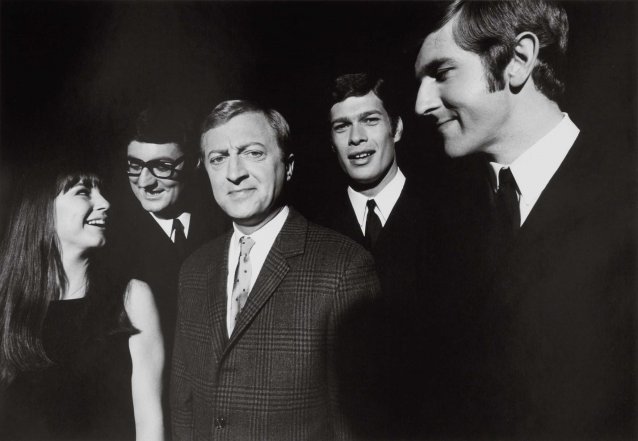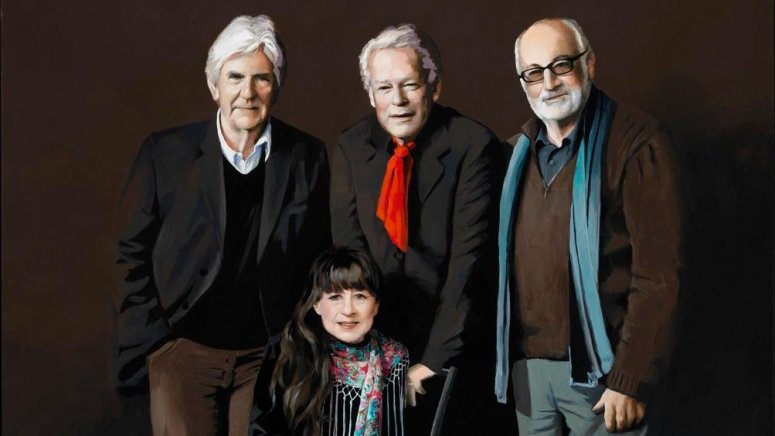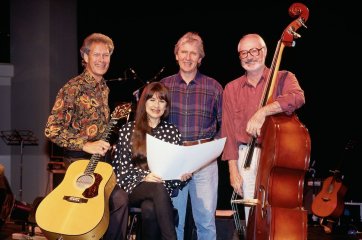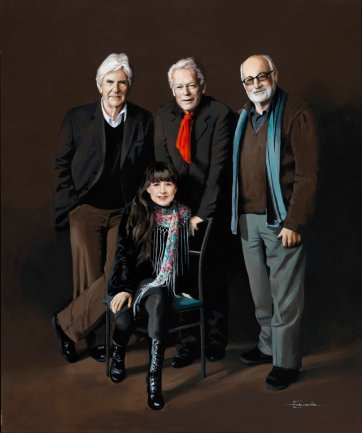The Seekers formed in Melbourne in 1962 when jazz singer Judith Durham (1943–2022) (left) met Athol Guy (second from left), who was in a folk trio with Bruce Woodley (right) and Keith Potger (second from right). With Durham on lead vocals, Guy on double bass and Potger and Woodley on guitars, they first performed together in a South Yarra coffee bar and released their debut LP, Introducing the Seekers, in 1963. The album was comprised largely traditional folk, gospel and African American spiritual songs such as 'This Train', 'All My Trials' and 'Kumbaya', each lent a jazz feel through harmonies and Durham's vocals. Signed to W&G Records, The Seekers released their first single – a version of 'Waltzing Matilda' – in November 1963. They then travelled to the UK as the on-board entertainment on a passenger cruise ship and within two days of their arrival in England in May 1964 they had appeared on The Tonight Show on BBC TV. They soon became regular guests on television and were offered an album deal with the World Record Club, for which they made the albums The Seekers and Hide and Seekers (the latter including a cover of Bob Dylan's 'Blowin' in the Wind'). In November 1964 they recorded 'I’'ll Never Find Another You' at EMI's Abbey Road Studios. By February 1965 the song had bumped The Kinks from top spot on the UK charts and made The Seekers the first Australian band to achieve a UK No. 1 single. Selling almost two million copies, it reached No. 1 in Australia and No. 3 in the USA. Described by one expert as 'too pop-oriented to be considered strictly folk and too folk to be rock', The Seekers appealed to fans spanning all three genres and were named the Best New Group of 1964 in a poll conducted by New Musical Express. In April 1965 they played Wembley Stadium in a bill that included The Beatles and The Rolling Stones, and later that year they appeared on the Ed Sullivan Show, their single 'A World of Our Own' having reached No. 2 on the US Billboard Easy Listening Chart. 'Morningtown Ride' spent fifteen weeks on the UK Singles Chart in 1966; and 'Georgy Girl' became a Top 5 hit in Australia, the UK, Canada and New Zealand, and reached number one on the US Cash Box Top 100.
In March 1967, The Seekers undertook their third Australian tour, during which they performed for some 200,000 people at the Sidney Myer Music Bowl in Melbourne. This portrait by Robert Whitaker of the band and the Australian television personality Graham Kennedy was taken the following year, when The Seekers were named joint Australians of the Year and featured in documentary special screened on Channel 9. Born in England to a British mother and an Australian father, Whitaker arrived in Melbourne as a '10 Pound Pom' in 1961. He became part of a circle that included Georges and Mirka Mora, Barry Humphries, Germaine Greer and Martin Sharp, and practised as a freelance photographer from his studio in Flinders Street. In 1964, when The Beatles were touring Australia, Whitaker photographed the band’s manager Brian Epstein for the Jewish News. Epstein was so impressed that he offered Whitaker the job of staff photographer at his company NEMS. The Seekers were among Whitaker's first subjects following his return to England; later, his trippy photograph of the quartet was used as the album cover for Seen in Green. He is best known, however, for his many photographs of The Beatles, including those used on the cover of Revolver, the EPs Nowhere Man and The Beatles' Million Sellers, and singles such as 'Day Tripper', 'I Feel Fine' and 'Paperback Writer'. Infamously, a surrealist-inspired photograph he took in 1966 for Yesterday and Today – known to longing collectors as the 'Butcher Sleeve' and featuring the Fab Four adorned with dismembered dolls and cuts of raw meat – was replaced by a more palatable image; a mint-condition record in the original sleeve is arguably the definitive Beatles collectible. The Seekers disbanded in 1968, bowing out with a week-long season at The Talk Of The Town in London (which provided material for a live album) and an hour-long BBC TV special. The 1968 compilation The Best Of The Seekers became their first UK No. 1 album, knocking The Beatles (aka 'The White Album') from top spot and preventing The Stones' Beggars Banquet from attaining it. The Best of The Seekers remained in the UK Top 40 for almost three years.
Collection: National Portrait Gallery
Purchased 2007
© Robert Whitaker
The National Portrait Gallery respects the artistic and intellectual property rights of others. Works of art from the collection are reproduced as per the
Australian Copyright Act 1968 (Cth). The use of images of works from the collection may be restricted under the Act. Requests for a reproduction of a work of art can be made through a
Reproduction request. For further information please contact
NPG Copyright.



















